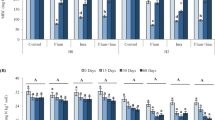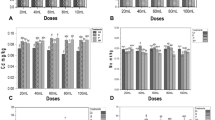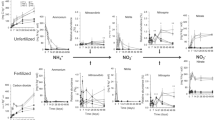Abstract
THE selective herbicides 2,4-dichlorophenoxyacetic acid (DCPA) and 2-methyl-4-chlorophenoxyacetic acid (MCPA) are known to undergo a gradual detoxication in soil due to biological agencies, and Audus1,2 has recently reported the isolation of a bacterium capable of decomposing the former, which is apparently utilized as a source of carbon. In the course of work on herbicide detoxication in soil, we have succeeded in isolating two types of bacteria with similar properties from soil repeatedly treated with 2,4-dichlorophenoxyacetic acid. Pure cultures were readily obtained by plating from soil on an agar medium containing 0.10 per cent sodium salt of the acid as the sole source of carbon. The first organism (No. 1) grew abundantly in ordinary bacteriological media and was identified as Flavobacterium aquatile (Bergey3). The second (No. 2) bore some morphological resemblance to the organism studied by Audus—small, irregular, non-spore-forming, non-motile rods of a Corynebacterium-like appearance, but Gram-negative, sometimes with Gram-positive granules. It grew very feebly in ordinary media and showed no conspicuous biochemical activities; but on ammonium phosphate agar with 0.1–0.2 per cent sodium salt of 2,4-dichlorophenoxyacetic acid or 2-methyl-4-chlorophenoxyacetic acid it produced a slow but eventually quite vigorous, whitish and slimy growth. A mere trace of growth occurred on the basal medium without added organic matter. Glucose and glycerol were utilized very poorly; phenol, sodium benzoate and sodium salicylate not at all.
This is a preview of subscription content, access via your institution
Access options
Subscribe to this journal
Receive 51 print issues and online access
$199.00 per year
only $3.90 per issue
Buy this article
- Purchase on Springer Link
- Instant access to full article PDF
Prices may be subject to local taxes which are calculated during checkout
Similar content being viewed by others
References
Audus, L. J., Nature, 166, 356 (1950).
Audus, L. J., Plant and Soil, 3, 170 (1951).
Bergey, D. H., “Manual of Determinative Bacteriology” (Baillière, Tindall and Cox, London; 6th edit., 1948).
Author information
Authors and Affiliations
Rights and permissions
About this article
Cite this article
JENSEN, H., PETERSEN, H. Detoxication of Hormone Herbicides by Soil Bacteria. Nature 170, 39–40 (1952). https://doi.org/10.1038/170039a0
Issue Date:
DOI: https://doi.org/10.1038/170039a0
This article is cited by
Comments
By submitting a comment you agree to abide by our Terms and Community Guidelines. If you find something abusive or that does not comply with our terms or guidelines please flag it as inappropriate.



